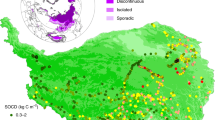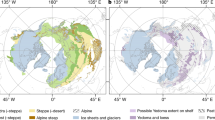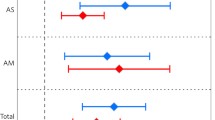Abstract
Permafrost soils are a significant global store of carbon (C) with the potential to become a large C source to the atmosphere. Climate change is causing permafrost to thaw, which can affect primary production and decomposition, therefore affecting ecosystem C balance. To understand future responses of permafrost soils to climate change, we inventoried current soil C stocks, investigated ∆14C, C:N, δ13C, and δ15N depth profiles, modeled soil C accumulation rates, and calculated decadal net ecosystem production (NEP) in subarctic tundra soils undergoing minimal, moderate, and extensive permafrost thaw near Eight Mile Lake (EML) in Healy, Alaska. We modeled decadal and millennial soil C inputs, decomposition constants, and C accumulation rates by plotting cumulative C inventories against C ages based on radiocarbon dating of surface and deep soils, respectively. Soil C stocks at EML were substantial, over 50 kg C m−2 in the top meter, and did not differ much among sites. Carbon to nitrogen ratio, δ13C, and δ15N depth profiles indicated most of the decomposition occurred within the organic soil horizon and practically ceased in deeper, frozen horizons. The average C accumulation rate for EML surface soils was 25.8 g C m−2 y−1 and the rate for the deep soil accumulation was 2.3 g C m−2 y−1, indicating these systems have been C sinks throughout the Holocene. Decadal net ecosystem production averaged 14.4 g C m−2 y−1. However, the shape of decadal C accumulation curves, combined with recent annual NEP measurements, indicates soil C accumulation has halted and the ecosystem may be becoming a C source. Thus, the net impact of climate warming on tundra ecosystem C balance includes not only becoming a C source but also the loss of C uptake capacity these systems have provided over the past ten thousand years.







Similar content being viewed by others
References
Bostrom B, Comstedt D, Ekblad A. 2007. Isotope fractionation and C-13 enrichment in soil profiles during the decomposition of soil organic matter. Oecologia 153:89–98.
Chapin FS, Matson PA, Mooney HA. 2002. Principles of ecosystem ecology. New York: Springer.
Dorrepaal E, Toet S, van Logtestijn RSP, Swart E, van de Weg MJ, Callaghan TV, Aerts R. 2009. Carbon respiration from subsurface peat accelerated by climate warming in the subarctic. Nature 460:616–79.
Dutta K, Schuur EAG, Neff JC, Zimov SA. 2006. Potential carbon release from permafrost soils of Northeastern Siberia. Glob Change Biol 12:2336–51.
Gaudinski JB, Dawson TE, Quideau S, Schuur EAG, Roden JS, Trumbore SE, Sandquist DR, Oh SW, Wasylishen RE. 2005. Comparative analysis of cellulose preparation techniques for use with C-13, C-14, and O-18 isotopic measurements. Anal Chem 77:7212–24.
Goulden ML, Wofsy SC, Harden JW, Trumbore SE, Crill PM, Gower ST, Fries T, Daube BC, Fan SM, Sutton DJ, Bazzaz A, Munger JW. 1998. Sensitivity of boreal forest carbon balance to soil thaw. Science 279:214–17.
Hobbie EA, Ouimette AP. 2009. Controls of nitrogen isotope patterns in soil profiles. Biogeochemistry 95:355–71.
Hua Q, Barbetti M. 2004. Review of tropospheric bomb C-14 data for carbon cycle modeling and age calibration purposes. Radiocarbon 46:1273–98.
Huemmrich KF, Kinoshita G, Gamon JA, Houston S, Kwon H, Oechel WC. 2010. Tundra carbon balance under varying temperature and moisture regimes. J Geophys Res Biogeosci 115.
Hugelius G, Kuhry P, Tarnocai C, Virtanen T. 2010. Soil organic carbon pools in a periglacial landscape: a case study from the Central Canadian Arctic. Permafrost Periglac Process 21:16–29.
IPCC (Intergovernmental Panel on Climate Change). 2007. Climate Change 2007: the physical science basis. In: Solomon S, Qin D, Manning M, Chen Z, Marquis M, Avery KB, Tignor M, Miller HL, Eds. Contribution of Working Group I to the fourth assessment report of the IPCC. New York: Cambridge University Press.
Kuhry P, Vitt DH. 1996. Fossil carbon/nitrogen ratios as a measure of peat decomposition. Ecology 77:271–5.
Lawrence DM, Slater AG, Romanovsky VE, Nicolsky DJ. 2008. Sensitivity of a model projection of near-surface permafrost degradation to soil column depth and representation of soil organic matter. J Geophys Res Earth Surf 113:14.
Levin I, Hesshaimer V. 2000. Radiocarbon—a unique tracer of global carbon cycle dynamics. Radiocarbon 42:69–80.
Lund M, Lafleur PM, Roulet NT, Lindroth A, Christensen TR, Aurela M, Chojnicki BH, Flanagan LB, Humphreys ER, Laurila T, Oechel WC, Olejnik J, Rinne J, Schubert P, Nilsson MB. 2010. Variability in exchange of CO2 across 12 northern peatland and tundra sites. Glob Change Biol 16:2436–48.
Malmer N, Holm E. 1984. Variation in the C/N-Quotient of peat in relation to decomposition rate and age-determination with PB-210. Oikos 43:171–82.
Michaelson GJ, Ping CL, Kimble JM. 1996. Carbon storage and distribution in tundra soils of Arctic Alaska, USA. Arctic Alpine Res 28:414–24.
O’Donnell JA, Harden JW, McGuire AD, Kanevskiy MZ, Jorgenson MT, Xu XM. 2011. The effect of fire and permafrost interactions on soil carbon accumulation in an upland black spruce ecosystem of interior Alaska: implications for post-thaw carbon loss. Glob Change Biol 17:1461–74.
Osterkamp TE, Jorgenson MT, Schuur EAG, Shur YL, Kanevskiy MZ, Vogel JG, Tumskoy VE. 2009. Physical and ecological changes associated with warming permafrost and thermokarst in interior Alaska. Permafrost Periglac Process 20:235–56.
Osterkamp TE, Romanovsky VE. 1999. Evidence for warming and thawing of discontinuous permafrost in Alaska. Permafrost Periglac Process 10:17–37.
Ping CL, Michaelson GJ, Kane ES, Packee EC, Stiles CA, Swanson DK, Zaman ND. 2010. Carbon stores and biogeochemical properties of soils under black spruce forest, Alaska. Soil Sci Soc Am J 74:969–78.
R Development Core Team. 2011. R: a language and environment for statistical computing. R Foundation for Statistical Computing, Vienna, Austria. ISBN 3-900051-07-0. http://www.R-project.org.
Raich JW, Russell AE, Kitayama K, Parton WJ, Vitousek PM. 2006. Temperature influences carbon accumulation in moist tropical forests. Ecology 87:76–87.
Schaefer K, Zhang T, Bruhwiler L, Barrett AP. 2011. Amount and timing of permafrost carbon release in response to climate warming. Tellus B 63:165–80.
Schuur EAG, Bockheim J, Canadell JG, Euskirchen E, Field CB, Goryachkin SV, Hagemann S, Kuhry P, Lafleur PM, Lee H, Mazhitova G, Nelson FE, Rinke A, Romanovsky VE, Shiklomanov N, Tarnocai C, Venevsky S, Vogel JG, Zimov SA. 2008. Vulnerability of permafrost carbon to climate change: implications for the global carbon cycle. Bioscience 58:701–14.
Schuur EAG, Crummer KG, Vogel JG, Mack MC. 2007. Plant species composition and productivity following permafrost thaw and thermokarst in Alaskan tundra. Ecosystems 10:280–92.
Schuur EAG, Vogel JG, Crummer KG, Lee H, Sickman JO, Osterkamp TE. 2009. The effect of permafrost thaw on old carbon release and net carbon exchange from tundra. Nature 459:556–9.
Shaver GR, Billings WD, Chapin FS, Giblin AE, Nadelhoffer KJ, Oechel WC, Rastetter EB. 1992. Global change and the carbon balance of arctic ecosystems. Bioscience 42:433–41.
Sterner RW, Elser JJ. 2002. Ecological stoichiometry. Princeton (NJ): Princeton University Press.
Stuiver M, Reimer P. 2010. Calib 14C Calibration Program. http://calib.qub.ac.uk/calib.
Tarnocai C, Canadell JG, Schuur EAG, Kuhry P, Mazhitova G, Zimov S. 2009. Soil organic carbon pools in the northern circumpolar permafrost region. Global Biogeochem Cycles 23:11.
Trumbore SE. 1997. Potential responses of soil organic carbon to global environmental change. Proc Natl Acad Sci USA 94:8284–91.
Trumbore SE, Bubier JL, Harden JW, Crill PM. 1999. Carbon cycling in boreal wetlands: A comparison of three approaches. J Geophys Res Atmos 104:27673–82.
Trumbore SE, Czimczik CI. 2008. Geology—an uncertain future for soil carbon. Science 321:1455–6.
Trumbore SE, Harden JW. 1997. Accumulation and turnover of carbon in organic and mineral soils of the BOREAS northern study area. J Geophys Res Atmos 102:28817–30.
Turetsky MR, Wieder RK, Vitt DH, Evans RJ, Scott KD. 2007. The disappearance of relict permafrost in boreal north America: effects on peatland carbon storage and fluxes. Glob Change Biol 13:1922–34.
Vogel J, Schuur EAG, Trucco C, Lee H. 2009. Response of CO2 exchange in a tussock tundra ecosystem to permafrost thaw and thermokarst development. J Geophys Res Biogeosci 114:14.
Vogel JS, Nelson DE, Southon JR. 1987. C-14 background levels in an accelerator mass-spectrometry system. Radiocarbon 29:323–33.
Wickland KP, Striegl RG, Neff JC, Sachs T. 2006. Effects of permafrost melting on CO2 and CH4 exchange of a poorly drained black spruce lowland. J Geophys Res Biogeosci 111:13.
Zimov SA, Davydov SP, Zimova GM, Davydova AI, Schuur EAG, Dutta K, Chapin FS. 2006. Permafrost carbon: stock and decomposability of a globally significant carbon pool. Geophys Res Lett 33:5.
Author information
Authors and Affiliations
Corresponding author
Additional information
Author contributions
CEHP helped design study, performed research, analyzed the data, and wrote the paper; EAGS conceived of study and contributed to writing the paper; and KGC performed research.
Rights and permissions
About this article
Cite this article
Hicks Pries, C.E., Schuur, E.A.G. & Crummer, K.G. Holocene Carbon Stocks and Carbon Accumulation Rates Altered in Soils Undergoing Permafrost Thaw. Ecosystems 15, 162–173 (2012). https://doi.org/10.1007/s10021-011-9500-4
Received:
Accepted:
Published:
Issue Date:
DOI: https://doi.org/10.1007/s10021-011-9500-4




